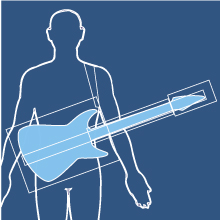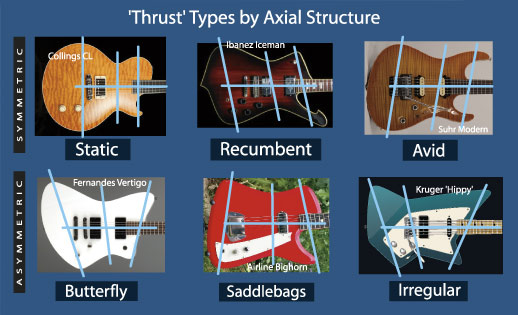Fundamentals of Electric Guitar Design, Part 1.
The purpose of these articles is to establish a system of analysis and terminology that will allow anyone to understand and describe any non-acoustic guitar design and visually critique or improve them. Many of the underlying principles are fairly obvious, but I’m going to imagine I’m describing them to a relative novice. I apologize to the more advanced.
I’m not trying to claim any higher Authority here, I’m just going to call things as I see them. While I’ve designed over 200 new guitar models, only two have been realized and I’ve never spent a day in the Industry, which may be good or bad. Meanwhile, I’ve gleaned a few insights.
The first thing to remember is that there are certain aspects of these guitars that are taken as read…
Number One being that they are virtually always designed around a central long axis. (The Spine) Designs that neglect or contradict this fundamental reality will always have problems, and show them.

Second, that guitars are made for humans to play, and must relate to the size range that we are. Ergonomics are a big part of making guitars that people like, and buy, and keep. Nearly every guitar body ever made was drawn inside an envelope about 18×24 or so, give or take. Solid bodies are generally 13×20 or less, as they’re heavier, unless chambered. Most necks are between 16 and 22″ long , depending on scale length. The vast majority have a headstock, and most of those fall somewhere inside of an area about 4×10″, tops. So if you’re setting out to design a new guitar model, it’ll probably fit in these ‘envelopes’.
Naturally there are exceptions to every rule, but if you can get finished designing every possible guitar in those parameters, give me a call. (Physics has shown that finite spaces can in fact house the infinite!) I’ve given this a lot of thought over the years, and really, most guitar bodies fall into only six general types, dependent on their overall Thrust. The way to discover this is to codify the pattern of the apparent Axes they have, drawn perpendicularly across the widest and narrowest points of their shape.

The human brain seizes on these extremes as a way of identifying shapes quickly. Our eyes are evolved to remember horizons, rock formations, animals, trees and plants,and the tools of daily life. Aside from the ones shown, there are bound to be oddball combinations, but those are disparate enough to dump into an ‘Irregular’ group. The others then are: Static, Avid, Recumbent, the Butterfly, and… SaddleBags, for lack of a more serious term. (I had a funnier one in mind, but would surely have gotten me in trouble!) This is a little-used type anyway and difficult to make work. If anyone coins a better term, I’m open to hearing it.
The reason most guitar designs will fit into the first three categories is because they rely on symmetry, across the Spine. Not all guitars require symmetry, but it’s a way to insure ‘non-failure’… it just always works. The Acoustic archetypes that Electrics descended from were symmetric, because regular shapes make regular noises… they just sound better. (Because they introduce fewer vibrational frequencies that affect the physical structure poorly.) So symmetry also visually suggests good sound. The only problem is that most symmetric guitar designs have been done, so finding new ones is tough.
Asymmetric guitar designs that are pleasing usually are because they achieve a Balance between their disparate elements, and that’s pretty much what symmetry does, in its more structured way. It’s just done through visual weighting.
Electrics evolved from acoustic Box guitars, and their ‘waisted’ structure (which stiffens the box) stayed with them, though I’ve yet to see any quantifiable reason for that, except history, and perhaps comfort, with a small nod to keeping them looking somewhat organic or feminine. So with that much inheritance, making new solid models without a waist is risky at best… though I’ve managed a few. At very least, one must remember that guitars are played in various positions, and a waist does help keep them from sliding off a player’s leg while seated.
So if you’re drawing a new model, it’s often desirable to work out the ‘bones’ first and then flesh it out from there. Each of the Thrust types will have its pluses and minuses that have to be worked out in relation to the player’s position, so it’s a good idea to work at full scale. Go to the guitar store and measure some successful guitar designs to understand a ratio of height to width generic to certain ‘families’ of guitars that people recognize and gravitate to. The Greeks discovered certain ratios like the Golden Mean (1:1.6) usually deliver an eye-pleasing balance… and a Strat body gets pretty close at 1:1.5. But again, there are no hard rules.
Naturally, longer scale instruments will allow body sizes to increase slightly, and short-scale necks will want smaller ones. Just understand that there will almost surely be some compromise in the ‘hanging balance’ of the full sized model’s prototypes, whether that means making the body smaller, the head longer, adding chambering, etc. Designing guitars on paper is one thing, 3D articles are a whole ‘nother bag of bobcats.

A Third ‘Given’ is that guitars are appreciated by human eyes, and they have their own wants and quirks. They ‘read’ objects in various ways. They scan the perimeter, [and different cultures will want to ‘read’ from one side or the other]. They ‘weigh’ the mass of the whole – and its parts, and they relate shapes to known motifs, and tend to attribute properties to objects by what they know of similarly shaped ones in their memory. For example, every time I show a new guitar design to anyone, they invariably seek to tell me what it’s closest to. It never fails.
So understanding how we See is a great start in learning how to please the eye. There’s a good book called The Astonishing Hypothesis that describes the process in full scientific detail. But you should also study sculpture, architecture, layout, photography, calligraphy, and even flower arranging for clues to how we see beauty and function.
Fourth on the list of Things We Can’t Avoid is that others have come before us, and designed many of the archetypal guitar designs that determine what works (or sells), and what doesn’t (or hasn’t). The fact is that any new design has a VERY small chance of displacing the icons we all inherited, and this is even truer depending on the knowledgeability of the buyer. The less they know, the more rigid their preconceptions – and their predilection to hanging on to that ignorance. Jumping on popular bandwagons is a lot easier than thinking. (It’s a bit like buying a Harley, one is washed in its aura and gains a certain cachet.) This is why so many feel justified in selling other peoples’ work, it works, and it’s occasionally legal, in certain cases. It’s important to remember, however, that Fender lost its case against all the Strat copyists because thirteen year old Guitar Center patrons didn’t know who designed it originally – because so many had stolen the design for so long that somehow it had become acceptable to consider it fair game. I kid you not. And this could happen to you. (I’ll just get it out of the way and state that I find it Ethically wrong to steal other peoples’ work.)
So any putative guitar designer needs to learn what has come before us, looking very closely and objectively at what has been done. And by inference, what HASN’T. Many guitar designs that are revered don’t necessarily deserve it, they just came along early… lots of them are downright ugly. Still, one should look for ways to combine good ideas, or explore the niches between them that have not been mined. Of course what we’re all after is that moment of real inspiration, bringing forth something truly new and archetypal, from nothing.

Early on, though, there’s no substitute for research, and the subject is nearly endless. Luckily, most of us can’t get enough guitars!
Next time… how I describe things, and some more principles for really seeing shapes. Comments and questions are welcome below, also you can contact me directly via the About page. Kerry Kruger.
9 thoughts on “Fundamentals of Electric Guitar Design, Part 1.”
Leave a Reply
You must be logged in to post a comment.


Are you aware of Rick Toone (www.ricktoone.com) and his ergonomic luthiery? His Orchid bass is an interesting solution.
Yes, Rick and I have been conversing for several years now. I agree, he’s pushing the envelope in every direction it will go.
Have no doubt his name will come up in subsequent articles, this one is by its nature very basic.
I find your blog intriguing to say the least, and frequently thought-provoking. Please do not take this next question as anything other than intellectual query. Why have you jumped into the middle of the design story here? Other luthiery / guitar engineering I have read the past few years would say the designed shape of a solid-body arises from the sound generation (strings supported from nut to bridge, anchored, and tuned), then forming propagation and sustain (added body mass/stiffness). Placement of the pickups under the strings is usually a compromise. Overall size is determined first by purpose (standard, baritone, bass, and so on) which drives scale length choice, and then by the design decision of how much resonant body to attach (e.g., Steinberger SS-2F , Gibson Les Paul Standard Bass Oversized, or Flying V ). Next I think is the step in the design sequence that your body shaping considerations come into play, followed by a possible adjustment of the design to locate one of the strap buttons to achieve body/neck neutral balance (c.f. any design with an extended upper bass bout “horn” tipped therewith).
Thanks for your interesting blogs. Keep writing!
All those things are exactly right. However the folks who first turned acoustics into electrics hadn’t a clue about the internal physics and simply began designing bodies that got closer and closer to what they were after through trial and error. [ I doubt the equipment needed to measure the vibrational frequencies you refer to were even invented yet, and if so probably not available to anyone but isolated scientists.] And we have a legacy of what they did to get along with, and past. We’re in the middle, so that’s where I began.
I make no claim to being an engineer, and while I am very much interested in that aspect, I will largely be discussing the visual aspect of designing guitars that are appealing. Some will argue that appearance is not a factor in making good guitars, and I would answer that while this is true, one still has to sell them. To quote Dr Lecter, “We covet what we see”. And this relies to a large degree on what buyers are comfortable and familiar with, only better. They will certainly move more slowly than those at the forefront of Theory.
So while they catch up I still believe we should make the most attractive objects we can. The nuances I’ll be looking at will in fact be applicable to advanced designs as well…in fact Rick Toone (see above) has suggested to me that I offer my services to some of his colleagues and followers who are great engineers but poor ‘draw-ers’.
I’ve simply been asked by some who have seen my work to describe how I see it and do it, so I’m offering that up.
I look forward to your input, you just wrote a third of an article for me, and I appreciate that !
Kerry – I really like the “Radius” guitar. So much in fact I think I’m going to build one. I’m a 51 year old cabinet maker who took up the guitar 6 months ago and I’m having a blast. Of course the first thing I want to do, before I can even play the thing, is build one. I found the stuff I was sketching looked alot like the “Radius”. Do you have anything more detailed you might be willing to let me see. It would help considerably, I’ve never built a guitar.
Well Bob, I’m flattered you like my design. And yes, I could furnish full-size vector patterns, etc.
should they become necessary.
Of course if you look closely, there’s a disclaimer in the artwork that clearly states that it is for consideration only, and that all rights to the design are reserved. Being published here and seen by many pretty well establishes that fact. So basically, you’ll need my consent to build one legally.
And since my name is on the design, and I’ll want it to come out to a certain standard, I’ll need to have some questions answered before granting license.
I’ve been in contact lately with another pure designer who has sucessfully leased his designs to a company who will build them, and that seems the best way to keep everyone on the up-and-up. Whether that lease is monetary or a barter agreement, I don’t mean to rain on your parade, I have an interest in seeing them made as well. I just need to maintain some control. So let’s talk, I’m listed in the Miami phone book, or see the Contact page here.
It is very refreshing to find a site like this one. It is full of helpful insights and written in an intelligent and entertaining manner.
Your skills as a designer far outweigh what you may think you lack in engineering; there ain’t that much engineering in solid bodies that make all that much difference compared to acoustic instruments. Experiment and listen I say;>)
More than once I hve been completely surprised at the sound of some guitars I thought for sure would sound terrible and found them to be screaming for my wallet!!!
Keep up the good work here, I for one appreciate it!
bc
This is a great article to have stumbled upon. I have built a knock off stratocaster for my first go at guitar building. Now that I have some experience in guitar making I am just dying to build a guitar of my own design. I am a trained sound engineer and have read articles that seem to confirm that the shape of an electric guitar body have very little to do with the sound. I am useless at visual design, but hopefully your tips will help me come up with an original design so that I can really build MY OWN guitar next time 🙂